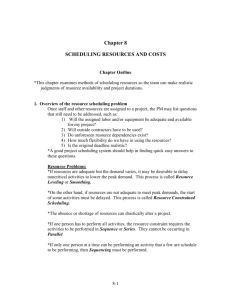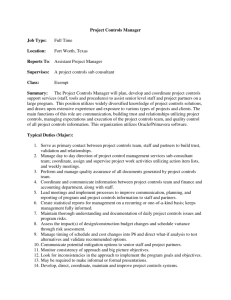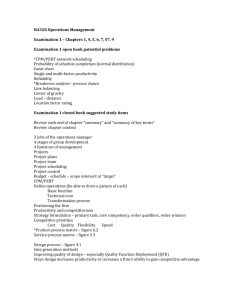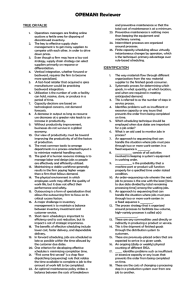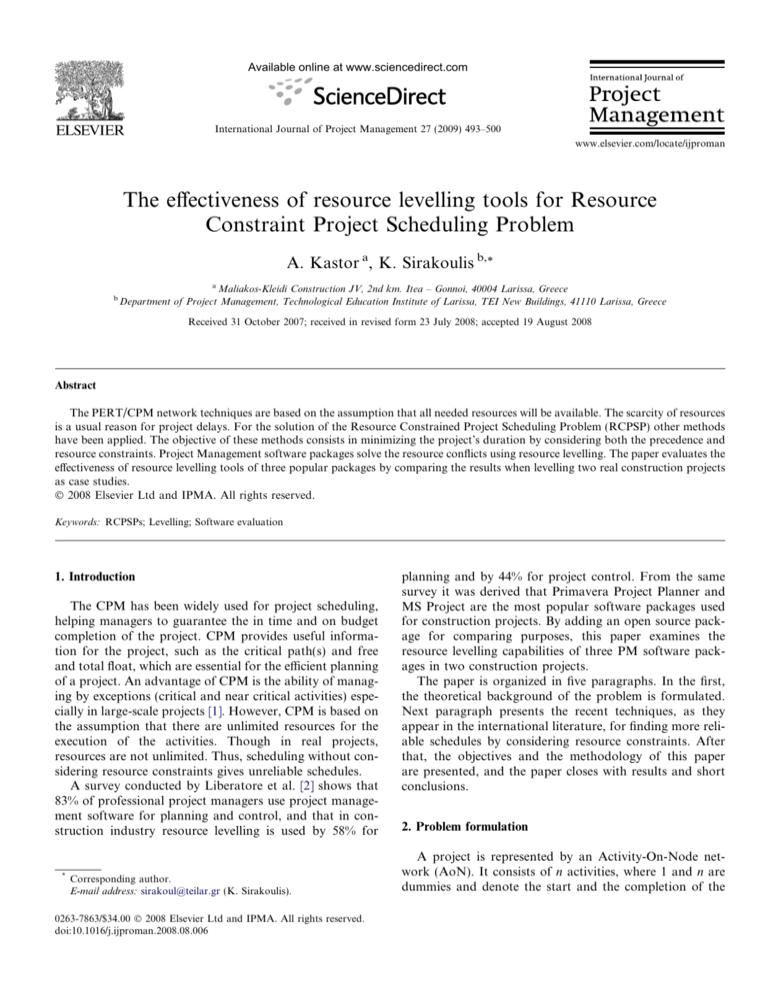
Available online at www.sciencedirect.com
International Journal of Project Management 27 (2009) 493–500
www.elsevier.com/locate/ijproman
The effectiveness of resource levelling tools for Resource
Constraint Project Scheduling Problem
A. Kastor a, K. Sirakoulis b,*
b
a
Maliakos-Kleidi Construction JV, 2nd km. Itea – Gonnoi, 40004 Larissa, Greece
Department of Project Management, Technological Education Institute of Larissa, TEI New Buildings, 41110 Larissa, Greece
Received 31 October 2007; received in revised form 23 July 2008; accepted 19 August 2008
Abstract
The PERT/CPM network techniques are based on the assumption that all needed resources will be available. The scarcity of resources
is a usual reason for project delays. For the solution of the Resource Constrained Project Scheduling Problem (RCPSP) other methods
have been applied. The objective of these methods consists in minimizing the project’s duration by considering both the precedence and
resource constraints. Project Management software packages solve the resource conflicts using resource levelling. The paper evaluates the
effectiveness of resource levelling tools of three popular packages by comparing the results when levelling two real construction projects
as case studies.
Ó 2008 Elsevier Ltd and IPMA. All rights reserved.
Keywords: RCPSPs; Levelling; Software evaluation
1. Introduction
The CPM has been widely used for project scheduling,
helping managers to guarantee the in time and on budget
completion of the project. CPM provides useful information for the project, such as the critical path(s) and free
and total float, which are essential for the efficient planning
of a project. An advantage of CPM is the ability of managing by exceptions (critical and near critical activities) especially in large-scale projects [1]. However, CPM is based on
the assumption that there are unlimited resources for the
execution of the activities. Though in real projects,
resources are not unlimited. Thus, scheduling without considering resource constraints gives unreliable schedules.
A survey conducted by Liberatore et al. [2] shows that
83% of professional project managers use project management software for planning and control, and that in construction industry resource levelling is used by 58% for
*
Corresponding author.
E-mail address: sirakoul@teilar.gr (K. Sirakoulis).
0263-7863/$34.00 Ó 2008 Elsevier Ltd and IPMA. All rights reserved.
doi:10.1016/j.ijproman.2008.08.006
planning and by 44% for project control. From the same
survey it was derived that Primavera Project Planner and
MS Project are the most popular software packages used
for construction projects. By adding an open source package for comparing purposes, this paper examines the
resource levelling capabilities of three PM software packages in two construction projects.
The paper is organized in five paragraphs. In the first,
the theoretical background of the problem is formulated.
Next paragraph presents the recent techniques, as they
appear in the international literature, for finding more reliable schedules by considering resource constraints. After
that, the objectives and the methodology of this paper
are presented, and the paper closes with results and short
conclusions.
2. Problem formulation
A project is represented by an Activity-On-Node network (AoN). It consists of n activities, where 1 and n are
dummies and denote the start and the completion of the
494
A. Kastor, K. Sirakoulis / International Journal of Project Management 27 (2009) 493–500
project. The fixed integer duration of activity j is indicated
by dj (16j6n), its integer start by sj (16j6n) and its integer
finish by fj (16j6n). There are K renewable resources with
rjk (16j6n, 16k6K), the constant resource requirement of
activity j for resource type k, and ak, the constant availability of resource k. Consequently, the resource constrained
problem can be formulated as follows:
Min f n
ð1Þ
Subject to
f1 ¼ 0
ð2Þ
fj d j fi 8ði; jÞH
X
rjk ak ; t ¼ 1; 2; :::; K
jS
t
ð3Þ
ð4Þ
where H denotes the set of pairs indicating precedence relationships and St, the set of activities in progress in time
interval ]t1,t]: St = {i|fi-di<t6fi}. Eq. (2) assigns a completion time of 0 to the dummy start activity 1. The precedence constraints given by Eq. (3) indicates that activity j
can only be started only if all its predecessors i are completed. The resource constraint given in Eq. (4) indicate
that for each time period ]t1,t] and for each renewable resource k, the resource amounts required by the activities in
progress cannot exceed the resource availability. The objective function is given as Eq. (1). The project duration is
minimized by minimizing the finishing time of the unique
dummy ending activity n [3].
Several exact and heuristics methods have been proposed for the solution of the RSPCP [4]. Exact methods
such as dynamic programming, zero–one programming
and implicit enumeration with branch and bound, aim
at finding the optimal solution. Thus they need a lot
of computational time, so they are inappropriate for
large and complex projects. Heuristic solutions, such as
priority rule-based scheduling, truncated branch and
bound, disjunctive arc-based heuristics, are very fast in
finding a solution, which makes them very practical,
but this solution may not be optimal but may be a near
optimal. Lately, some meta-heuristic techniques, such as
genetic algorithms, simulating annealing, and tabu
search, have been applied.
Most project management software employ priority
rule-based heuristics for resource levelling. Priority rulebased scheduling consists of two components: a scheduling
scheme and a priority rule. There are two scheduling
schemes: serial and parallel. In serial scheduling, a decision
set is formed at each scheduling time and contains all the
unscheduled activities that are precedence feasible (all their
predecessors have been scheduled), while in parallel scheme
the decision set is formulated from all the unscheduled
activities that are precedence and resource feasible at the
scheduling time. A priority rule is then applied in order
to select one activity from the set which will be scheduled
[5]. Some examples of priority rules are: minimum slack,
minimum latest finish/start time, and shortest processing
time, but there are many different priority rules.
When considering resource constraints in scheduling,
some critical activities may be delayed because of resource
unavailability. In that case, the sequence of the critical path
is lost [6]. Critical sequence was proposed by Weist [6] to
find critical activities by considering both precedence relations and resource constraints. Activities in the critical
sequence affect the projects completion, like the critical
path for the resource unconstrained case. Weist [7] proposed a heuristic approach for the solution of resource constrained problem with constant resource limits, and
Woodworth and Shanahan [8] developed a method for
the calculation of the resource constrained float. Li and
Willis [9] used the critical sequence in their time/cost
trade-off algorithm for the resource constrained problem,
but they did not calculate the float. Bowers [1] proposed
a set of heuristics based on the critical sequence for the calculation of the resource constrained float. These algorithms
assumed a fixed critical sequence with an invariant resource
allocation.
3. Literature review
However, a resource constrained project network may
have a lot of equivalent schedules [1]. An example of equivalent schedules is given in Fig 2, where two equally good
solutions of network A (Fig. 1) are depicted. Activities 3
and 4 have the same duration, resource requirement, predecessors and successors, but in schedule (a), Activity 3 is
critical and Activity 4 has a significant float, while in schedule (b), Activity 4 is critical and Activity 3 has a significant float. Raz and Marshall [10] introduced the early
and late scheduled dates, which are the early and late dates
of the activities, by considering both precedence relations
and resource constraints. A heuristic algorithm was applied
for the calculation of the early scheduled dates. Inversing
this algorithm and starting from the early scheduled finish
of the project, they calculated the late scheduled dates.
Then, they calculated the scheduled total and free float
using the classic way. Goldratt [11] proposed a methodology for the identification of the Critical Chain, which is
defined as ‘‘the longest chain of dependant steps”, where
‘‘dependencies between steps can be a result of a path or
a result of a common resource” [11]. Critical Sequence
and Critical Chain are based on the same concept. The difference is that critical chain uses reduced activity durations.
Goldratt reduced the activity duration by assuming that it
contains a protection against uncertainty and used this protection in some strategic positions in the schedule by adding time buffers.
Bowers [12] used some perturbations of the network
inorder to generate the alternative schedules. Tormos and
Lova [13] complement the concept of Backward and Forward Free Slack from Lova et al. [14] with the Backward
and Forward Total Slack for the calculation of Resource
Constrained Activity Criticality Index (RC ACI), and they
integrated their method into Microsoft Project ‘98. Forward Free Slack of an activity is the amount of time in
A. Kastor, K. Sirakoulis / International Journal of Project Management 27 (2009) 493–500
495
Fig. 1. Network A (source [1]).
Fig. 2. Equivalent Schedules of Network A (source [1]).
which the activity can be right-shifted allowing the successors to start on their scheduled dates. Backward Free Slack
of an activity is the amount of time in which the activity
can be left-shifted allowing the predecessors to start on
their scheduled dates. Forward and Backward Free Slacks
do not take into account resource constraints. Respectively, Forward and Backward Total Slack of an activity
is amount of time in which the activity can be executed earlier or later, maintaining both the feasibility and the project
completion time.
Fondahl [15] remarks that, as soon as resources are considered in a project, the original calculated network data,
which are used as priority rules, are activity attributes
and may have no meaning in resource constrained scheduling. For that reason Lu and Li [16] proposed the ResourceActivity Critical Path Method (RACPM), in which ‘‘the
dimension of resources is considered in addition to activity
and time” [16]. The RACPM is a serial path heuristic
method based on the knowledge-based system of Waugh
and Froese [17], which can handle both renewable and
non-renewable resources and uses work content as a priority rule.
Kim et al. [18] developed the Resource Constrained
Critical Path Method (RCPM) for the calculation of the
resource constrained float without the phantom float. Phantom Float is called the difference between the theoretical
remaining total float and the actual remaining total float
[18]. This difference is the result of using the CPM for the
backward scheduling after the resource constrained forward scheduling. This Phantom Float exists in project
management software packages when executing resource
levelling. An example of phantom float is shown in
Fig. 3. Activities A–D share the same resource with constant availability of 1. Each activity requires 1 per day.
When levelling the CPM schedule activities A and B seem
to have a total float of 2 periods, but if activity B is
delayed, the entire project will be delayed due to the use
of a common resource. Hence, the float of the 2 periods
does not exist. The advantages of RCPM are
Gives more realistic schedules since it takes into
account resource availability.
Identifies the critical path and calculates floats
correctly.
Provides a stable schedule in a certain required level
throughout the project duration.
At a specific time period of a project, a pair of activities
may be critical (limit the advancement of the project). This
496
A. Kastor, K. Sirakoulis / International Journal of Project Management 27 (2009) 493–500
Fig. 3. Phantom float in P3.
means that if either of them is delayed, the project completion wouldnot be affected. But, any delay in both of them
would delay the project. This pair of activities consists a
critical set [19]. If there is more than one critical set within
the same time period, then the project’s completion is limited by a critical cloud [19]. Rivera and Duran [19] developed an algorithm for identifying critical sets and clouds.
Evaluations of resource levelling capabilities of project
management software were performed by Johnson [20],
Maroto and Tormos [21], Burley [22], Farid and
Manoharan [23], Maroto et al. [24] and Kolisch [25]. Johnson [20] used the 110 problems of Patterson [26] to compare
13 versions of 7 project management software packages.
Johnson compared the results given from the software packages with the optimal solutions of the problems as given by
Demeulemeester and Herroelen [27]. Maroto and Tormos
[21] used one problem with 51 activities and three resources
to compare 7 versions of 6 software packages. Burley [22]
compared Microsoft Project 3.0, Project Manager Workbench/w and Timeline 6.0, and Farid and Manoharan [23]
compared Microsoft Project 3.0, Primavera Project Planner,
Project Scheduler 5.0 and Time Line. Maroto et al. [24] evaluated six software packages: CA Superproject v.4.0, Microsoft Project v.4.0, Project Scheduler 6 v1.5, Time Line v.6,
Primavera Project Planner v.2 and Artemis Schedule Publisher v.4.2. Ninety-six projects were generated for the evaluation of these software. The 96 projects were solved from
the six software packages, and the results were compared
against the optimal solutions obtained by the Branch and
Bound procedure of Demeulemeester and Herroelen [27], 2
heuristics (MINLFT, FCFS) and the TRC Method. Kolisch
[25] compared the solutions given by seven software packages: Artemis Schedule Publisher v.4.1, CA Superproject
v.3.0 C, Microsoft Project v.4.0, Primavera Project Planner
1.0, Project Manager Workbench v.1.1.02w, Project Scheduler 6.0 v.1.02 and Time Line v.6.0 with the solution given by
the Branch and Bound procedure of Demeulemeester and
Herroelen [27] on 160 instances.
4. Objectives and methodology
The objective of this paper is to analyze the quality of
resource constrained scheduling of project management
software, by evaluating two widely used software packages
[2], Primavera P6.0 and Microsoft Project 2007, and one
open source, Open Workbench 1.1.6. Furthermore, the
paper compares the results with the previous versions of
these software packages, e.g. Primavera Project Planner
v.3.1, Microsoft Project 2003 and Open Workbench 1.1.3.
Project management software packages usually use priority rule-based heuristic algorithms for the resource levelling, but they donot offer other information about the
details of the algorithm, e.g. which scheduling scheme or
which priority rule they use, if it is static or dynamic.
Primavera Project Planner gives the user the opportunity
to the user to choose the priority rule but it doesnot illustrate to the user the possible usefulness of changing the priority rule or using more than one. These criteria can cause
many possible methods which can end up to a different
schedule. Therefore, the paper examines the effectiveness
A. Kastor, K. Sirakoulis / International Journal of Project Management 27 (2009) 493–500
of resource levelling of the software packages on two real
construction projects to show that the duration of the project, when considering resource constraints, depends on the
software and/or the method used.
The first benchmark instance is a real housing project
which consisted of 96 houses. The focus was on the concreting of these 96 houses because there was problem.
The project has 98 activities, and 1 renewable resource
(concrete) was considered. According to the projects initial
plan, the average daily concrete requirement, during the
projects horizon, was 112.28m3 with a maximum of
126.4m3 but the constructor could procure only 80m3.
The following parameters were used inorder to determine
the complexity of the problem [28]: The Network Complexity (NC), which measures the average number of precedence relations per activity. The Resource Factor (RF),
which defines the average number of constrained resources
requested by an activity. RF is normalized to the interval
[0, 1]. For RF=1, each activity requires every one of the
R resources, and for RF= 0, none of the activities requires
any of the resources. The resource strength (RS), which
measures the proportion of resource demand and availability RS, is also normalized to the interval [0,1], and for
RS=0 the problem is highly resource constrained, while
for RS=1, the project is resource unconstrained. For this
instance, the values are NC=2.6, RF=1 and RS=0.62.
The second instance is the construction of a shopping
mall consisting of 19 buildings. When the resource levelling
was applied, the project was in progress and the contractor
wanted to program the remaining work, especially electromechanological and activities requiring specialised work,
by considering the availability of workgroups. The timeschedule consists of 668 activities and 7 renewable
resources. The complexity factors for this instance are
NC = 0.86, RF = 0.05, and RS equals 0 for 5 of the seven
resources and 0.4 and 0.5 for the other two.
Microsoft Project and Open workbench use a standard
built-in procedure so there is one result for each. For P6,
besides the default resource levelling, six priority rules
and all possible combinations between them were used,
so P6 obtained 31 results. The priority rules used are Late
Start Time (LST), Late Finish Time (LFT), Minimum
Slack (MSLK), Ranked Positional Weighted Method
(RPWM) and Enhanced Positional Weighted Method
(EPWM). The last two rules do not exist in Primavera,
but were computed and imported to Primavera as Custom
497
Data Items. The comparison of these results made using
the percentage deviation from the project duration without
resource constraints, which is 464 days for instance 1 and
238 for instance 2.
5. Results
On comparing the default options given from the software (Table 1), Primavera P6 gives the best results and is
followed by MS Project in both the instances. Open Workbench has a great deviation especially in the second
instance.
On comparing all the results (Table 2), Primavera P6
default and by LST rule give the best solution for both
instances with an average deviation of 41.11%. MS Project is ranked 3 (46.14%) and is followed by P6 by
RPWM and by LFT (47.19%). The worst result was given
by Open Workbench with an average deviation of
167.79%. Especially in the second instance, Open Workbench gives a duration that is over the double from
CPM duration. A point to be noted is that P6 by EPWM
rule gives the best solution for the second instance, which
is not the case for the first instance. Also MS Project in
the first instance gives the same result with P6 by PWM
and LFT, but in the second instance gives slightly better
solution.
The evaluated software can be divided into three groups
according to the quality of the schedules they produce. The
first group consisted of those who have a better performance (average deviation less than 50%), which are P6
default, P6 by LST, MS Project, P6 by LFT and P6 by
PWM. The second group contains the medium quality software (average deviation 50% to 60%), which are P6 by
EPWM and P6 by MSLK, and the third group is formed
by the worst quality software (average deviation over
60%), which is P6 by SPT, and the result of Open Workbench is not included as it is an outlier (Fig. 4).
The two instances that are also solved by Primavera,
combining 2 priority rules and the average results are presented below (Table 3). The first rules are given in the rows
and the second rules are given in the columns. Better results
are given from LST, LFT and PWM when used as first
rules. For tie breaking rule, better results are given by
EPWM, PWM and LST. The combination of PWM and
LST and the combination of LST and MSLK give the best
solution for both the instances.
Table 1
Duration and percentage deviation obtained by the project management software for default options
Rule
P6 Default
MS Project standard
Open workbench
standard
1st Instance
2nd Instance
Average
Duration
Percentage deviation from
CPM (%)
Duration
Percentage deviation from
CPM (%)
Average percentage deviation from
CPM (%)
709
744
863
52.80
60.34
85.99
308
314
832
29.41
31.93
249.58
41.11
46.14
167.79
498
A. Kastor, K. Sirakoulis / International Journal of Project Management 27 (2009) 493–500
Table 2
Duration and percentage deviation obtained by the project management software
Rule
LST
P6 Default
MS Project
standard
PWM
LFT
EPWM
MSLK
SPT
Open workbench
standard
1st Instance
2nd Instance
Average percentage deviation
from CPM (%)
Duration
Percentage deviation from
CPM (%)
Rank
Duration
Percentage deviation from
CPM (%)
Rank
709
709
744
52.80
52.80
60.34
1
1
2
308
308
314
29.41
29.41
31.93
1
1
2
41.11
41.11
46.14
744
744
823
823
893
863
60.34
60.34
77.37
77.37
92.46
85.99
2
2
3
3
4
5
319
319
308
327
336
832
34.03
34.03
29.41
37.39
41.18
249.58
3
3
1
4
5
6
47.19
47.19
53.39
57.38
66.82
167.79
Fig. 4. Performance in resource constrained project scheduling.
Table 3
Combinations of priority rules in Primavera P6
EPWM
PWM
LFT
LST
MSLK
SPT
Average
EPWM(%)
PWM(%)
LFT(%)
LST(%)
MSLK(%)
SPT(%)
Average(%)
–
43.42
43.84
44.39
56.12
48.58
47.27
53.39
–
45.85
42.08
53.18
48.65
48.63
51.87
45.30
–
42.08
57.38
54.67
50.26
53.39
41.11
41.95
–
57.38
54.67
49.70
57.38
45.10
47.61
41.11
–
66.07
51.45
60.28
55.72
48.03
42.08
57.38
–
52.70
55.26
46.13
45.45
42.34
56.29
54.53
6. Conclusions
This paper evaluated the resource levelling capabilities
of three project management software packages on two real
construction problems. The results show that the project
duration depends on the software or the method used. It
could be supported that, for problems of that size and complexity and objective function the makes pan minimization,
there is an increase in makespan from 41.11% to 167.79%
of the resource unconstrained schedule and that Primavera
P6 outperforms MS Project and Open Workbench.
Because of the big range of the results, project managers
should not rely on the first result they get but try other
rules or even software if possible.
Primavera P6 is the most effective as it allows the user to
define theoretically unlimited number of criteria as priority
rules. For the other software, the main problems are that in
MS Project the user cannott have constraint on a material
(user has to manage it as labor) and that Open Workbench
was too slow when scheduling. Previous versions of the
A. Kastor, K. Sirakoulis / International Journal of Project Management 27 (2009) 493–500
same software programs, e.g. Primavera Project Planner
v.3.1, MS Project 2003 and Open Workbench 1.1.3, gave
exactly the same results.
Regarding the different methodology used in the previous evaluations, it is not easy to make an exact comparison
of the results. Johnson [20] compared seven software packages, with MS Project (1.0 and 3.0) and Primavera (4.0, 4.1
and 5.0) among them, against Talbot’s Optimizer [29] and
Patterson Heuristic [30] on the 110 Patterson’s problems.
The results showed that Timeline was the most successful
with an average of 5.03% over the optimal solution. MS
project was the least successful. Found the optimal solution
for 10 projects, and had an average of 25.6% over the optimal solution. Primavera had an average of 7.45% over the
optimal duration. Maroto and Tormos [21] compared the
results from seven software packages against CPM on a
project with 51 activities and three resources. They did
not use the product of Primavera. MS Project 3.0 was
within the first three that outperformed. Farid and Manoharan [23] used 10 of the 110 Patterson’s problems to compare five software packages against Talbot’s Optimizer [29]
and Patterson Heuristic [30]. MS Project v.3.0 and Primavera Project Planner v.5.0 are ranked last (fourth and fifth,
respectively). Maroto, Tormos and Lova [24] compared six
software packages on 96 auto-generated problems against
Branch and Bound procedure from Demeulemeester [31].
Primavera standard, Primavera by LFT and MS Project
are placed in the group of medium quality. Primavera by
MSLK was placed in the third group of worst performance. Kolisch [25] used seven software packages on 160
instances against Branch and Bound procedure from
Demeulemeester and Kolisch [31]. Primavera Project Planner v.1.0 was placed in the first group of best performance,
Microsoft project in the second and Project Manager
Workbench v.1.1.02w in the third.
Our results seem to be consistent with the evaluation of
Maroto et al. [24]. Primavera standard, Primavera by LFT
and MS Project are placed in the same group (first for us
second for Maroto et al., while Primavera by MSLK is
placed in the next one.
CPM is inappropriate for scheduling resource constrained projects, and project managers shouldnot rely only
on this method when dealing with limited resources [32].
Project management software packages should incorporate
other more efficient methods for resource constrained
scheduling and should try to illuminate some drawbacks
such as Phantom Float. It would be also interesting if project management software could have other objectives,
besides the makespan minimization, such as maximizing
the net present value.
References
[1] Bowers JA. Criticality in resource-constrained networks. J Oper Res
Soc 1995;46(1):80–91.
[2] Liberatore MJ, Pollack-Johnson B, Smith CA. Project management
in construction: software use and research direction. J Constr Eng
Manage 2001;127(2):101–7.
499
[3] Herroelen W, De Reyck B, Demeulemeester E. Resource-constrained
project scheduling: A survey of recent developments. Comput Oper
Res 1998;25(4):279–302.
[4] Kolisch R, Padman R. An integrated survey of deterministic project
scheduling. Omega 2001;29(3):249–72.
[5] Kolisch R, Hartmann S. Heuristic algorithms for the resourceconstrained project scheduling problem: classification and computational analysis. In: Weglarz J, editor. Project Scheduling: recent
models, algorithms and applications. Boston: Kluwer Academic
Publishers; 1998.
[6] Wiest JD. Some properties of schedules for large projects with limited
resources. Oper Res 1964;12(3):395–428.
[7] Wiest JD. A heuristic model for scheduling large projects with limited
resources. Manage Sci 1967;13(6):b359–77.
[8] Woodworth BM, Shanahan S. Identifying the critical sequence in a
resource constrained project. Int J Project Manage 1988;6(2):89–96.
[9] Li RK-Y, Willis RJ. Resource constrained scheduling within fixed
project durations. J Oper Res Soc 1993;44(1):71–80.
[10] Raz T, Marshall B. Effect of resource constraints on float calculations
in project networks. Int J Project Manage 1996;14(4):241–8.
[11] Goldratt E. Critical chain. Great Barrington: The North River Press
Publishing Corporation; 1997.
[12] Bowers J. Multiple schedules and measures of resource constrained
float. J Oper Res Soc 2000;51(7):855–62.
[13] Tormos P, Lova A. Tools for resource-constrained project scheduling
and control: forward and backward slack analysis. J Oper Res Soc
2001;52(7):779–88.
[14] Lova A, Maroto C, Tormos P. A multicriteria heuristic method to
improve resource allocation in multiproject scheduling. Eur J Oper
Res 2000;127(2):408–24.
[15] Fondahl JW. The development of the construction engineer: past
progress and future problems. J Constr Eng Manage 1991;117(3):
380–92.
[16] Lu M, Li H. Resource-activity critical-path method for construction
planning. J Constr Eng Manage 2003;129(4):412–20.
[17] Waugh LM, Froese TM. Constraint knowledge for construction
scheduling. In: IEE Conf. Publ. Institute of Electrical Engineers,
London, UK; 1990. p. 114–118.
[18] Kim K, De La Garza JM. Phantom float. J Constr Eng Manage
2003;129(5):507–17.
[19] Rivera FA, Duran A. Critical clouds and critical sets in resourceconstrained projects. Int J Project Manage 2004;22(6):489–97.
[20] Johnson RV. Resource constrained scheduling capabilities of commercial project management software. Project Manage J 1992;22(4):
39–43.
[21] Maroto C, Tormos P. Project Management: An evaluation of
software quality. Int Trans Oper Res 1994;1(2):209–21.
[22] Burley E. Resource levelling with project management software. In:
Paper presented at the INFORMS International Meeting, Singapore;
1995.
[23] Farid F, Manoharan S. Comparative analysis of resource-allocation
capabilities of project management software packages. Project
Manage J 1996;24:35–44.
[24] Maroto C, Tormos P, Lova A. The evolution of software quality in
project scheduling. In: Weglarz J, editor. Project scheduling–recent
models, algorithms and applications. Boston: Kluwer Academic
Publishers; 1998.
[25] Kolisch R. Resource allocation capabilities of commercial project
management software packages. Interfaces 1999;29(4):19–31.
[26] Patterson JH. A comparison of exact approaches for solving the
multiple constrained resource, project scheduling problem. IIE Trans
1984;30(7):854–67.
[27] Demeulemeester E, Herroelen W. A branch and bound procedure for
the multiple resource-constrained project scheduling problem. Manage Sci 1992;38(12):1803–17.
[28] Kolisch R, Sprecher A, Drexl A. Characterization and generation of a
general class of resource-constrained project scheduling problems.
Manage Sci 1995;41(10):1693–703.
500
A. Kastor, K. Sirakoulis / International Journal of Project Management 27 (2009) 493–500
[29] Talbot FB, Patterson JH. An efficient integer programming algorithm
with network cuts for solving resource constrained scheduling
problems. Manage Sci 1978;24(11):1163–74.
[30] Patterson JH. Project scheduling: the effects of problem structure
on heuristic performance. Naval Res Logist Quart 1976;23(1):
95–123.
[31] Demeulemeester E, Kolisch. A branch and bound procedure for the
multiple resource constrained projects scheduling problem. Manage
Sci 1992;38(12):1803–18.
[32] Herroelen W, Leus R. Identification and illumination of popular
misconceptions about project scheduling and time buffering in a
resource-constrained environment. J Oper Res Soc 2005;56:102–9.



